Double Cinema
2000
double-channel video projection in installation, 2 x 13 min.
A double-channel video about a focus-group room, it's mirror and division of spaces. Two sides of the mirror become two different films, but with one, shared soundtrack. The two films are installed in the same space, but cannot be viewed simultaneously.
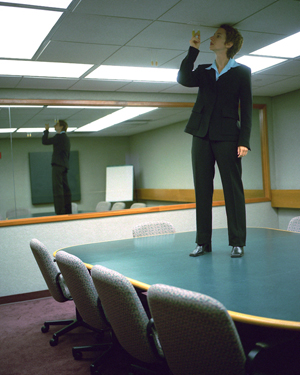
View the two videos here - please note: They have been put together in one track for this viewing situation. The soundtrack will thus be repeated.
DOUBLECINEMA singlechannel vimeo from Katya Sander on Vimeo.
Installation:
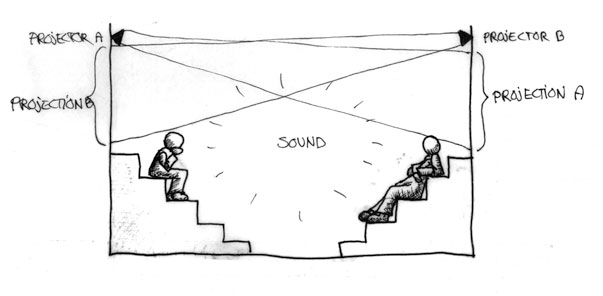
The installation resembles two cinemas pushed together to form one space: a space in which the two screens and two sides of seats face each other.
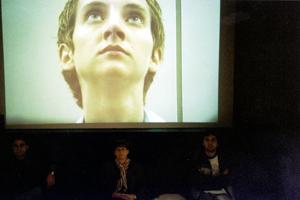 
The projector for each screen is placed on top of the opposite screen, so that the projections cross each other as they fall through the room, just as the viewers’ gazes cross each other as they look towards opposite screens. The view when watching one of the screens will always consist of the video projection, the projector, and the spectators across the room. The ‘empty’ center in the middle, between the two viewing-tribunes, is a space for movement of bodies, projections and gazes.
The videos are different, but there is only one soundtrack which they share.
This mirroring of the spectators viewing positions and the screens a well as projectors relates directly to the content of the two videos.
The videos
 
Location
The two videos projected are shot in focus-group rooms. A focus-group room is a space bisected by a large one-way mirror, which reflects on the brighter side (where those being observed—the test-group—sit) and is transparent from the darker side (where the observers—the client-group—sit). These two sides are completely separated by the mirror and the groups on either side never meet. The mirror allows the ones who sit on one side to see people on the other side without being seen themselves (if the side stays dark). The mirror is sound-proof, and microphones and a sound-system transmits the sound from the observed side to the observing side.
The two sides are carefully kept apart; they have separate entrances and the two groups never meet each other. The only person who operates on both sides is the moderator; the person working for the focus-group company, in charge of hosting the guests, keeping the discussion on track, making sure that the clients on the other side get what they need, as well as advising them on how to use the space. The room is an instrument or apparatus of a profession and the moderator is the professional user of this instrument.
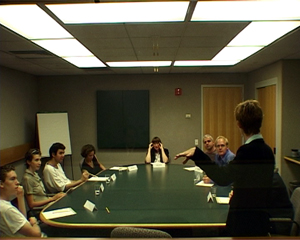 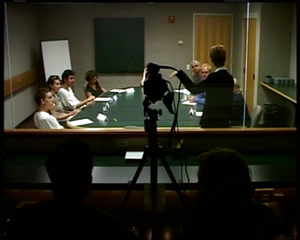
As a point of departure, the two videos projected opposite each other can be understood as representing each side of the mirror, but this symmetry is problematized as the focus-group session unfolds. This unfolding does not happen in a way in which the spectator will be lead to any conclusions. Rather, the explanatory aspects remain on the level of the space and its logic. It is the space that creates the modes of interaction and understanding more than it is any psychological ‘character’ or ‘action’. There is a single soundtrack for both projections, so that although one can only see one projection at a time, there are sounds which suggest that something else is going on beyond that screen and that this something else could be found on the screen directly above them.
 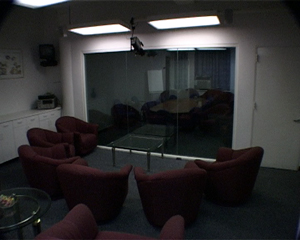
The pushing together of the two cinemas pulls apart the mirror that bisects the focus-group session, so that the viewers now come to inhabit this space in-between the two spaces, between the observed and the observing, inhabiting both roles simultaneously, observing the projection and the spectators just under it who in turn are observing them and the projection just above them. An arena of spectators in the middle of a mirror.
Factual notes about focus-groups
Focus-group rooms are built by marketing-research companies who rent them out to their clients on a hourly basis for the specific purpose of making it possible for the clients to watch and listen directly, live, to consumers talking about their products. The use of focus-group rooms has exploded within the last 10 years, and is today considered one of the most important instruments for marketing research in the western world. It was originally designed for testing marketing campaigns for products, but today one of the largest groups of users of focus-group rooms are politicians and political parties, who see the set-up as a chance to listen to the 'man on the street'. Language, angles of approach and subject issues are carefully tested and analyzed with focus-groups before campaigning strategies or strategies for public appearance are decided upon.
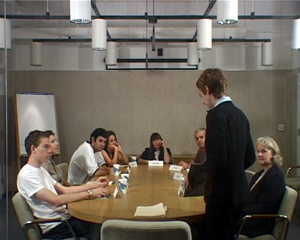 
The content / storyline(s)
The videos are structured around an at first sight linear story-line: The spaces and their logics are established, and a person is introduced as the one who works or operates these spaces. This person is the moderator. She leads the test-group and the client-group separately to their respective sides of the mirror, and introduces both groups to each other, in two different ways. The moderator operates on both sides of the mirror and is supposedly the one who controls the space, but also the one who serves it. The focus-group session takes place, but the linearity doesn’t lead to any obvious conclusions.
The aim of the 'stories' of the two videos is that they both seemingly depend upon each other. Both sides give clues to the understanding of each other but there is no synthesis of a 'story' as such. The explanatory aspects stay on the level of the space and its logic. It is the space that creates the modes of interaction and psychological understanding more than it is any 'character' or 'action'.
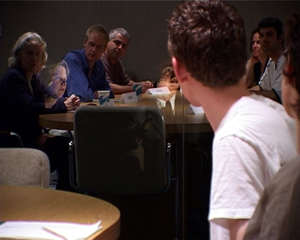 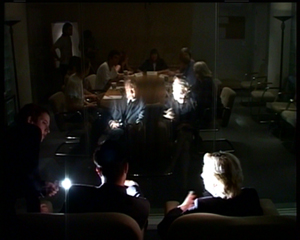
The sound-track
The soundtrack is important. It is constructed to support both sides / both videos without obstructing the other, but still constantly – almost subconsciously – reminding the spectator that there is 'something else going on as well' (i.e. the video above ones own head that the people across the room are watching). The two sides are thus edited to share many sounds, but also to give space and time to underline the sounds they do not share.
When watching both sides, one will hear the soundtrack twice; it will be repeated but have different image-sides, different interpretations. The sound is – so to speak – a meeting between the two image-sides, an overlapping, doubling as a partly misguiding erasure or fragmentation, constantly reminding the spectator of the suspending or postponing of the 'unity' of the story, either towards a soon-to-be future (when the other side is seen) or a very recent past (when the first side was just seen).
The videos in relation to the spatial construction
The two videos are produced specifically for this installation. As a point of departure the two videos can be understood as representing each side of the mirror. But the obvious symmetry of the physical installation soon becomes questioned by the relationship between the two sides on the two videos: At first they seem equally symmetrical as well, mirroring the physical installation, but as the spectator moves over to watch both sides - perhaps more times - it becomes obvious that there is also a certain asymmetrical relationship: both views depend on each other, but one view seems to contain the other. On the other hand, it also seems that the side that is normally not visible – the client side – becomes visible for observation by the spectator in the installation, while the observed side – the focus-group – seems more aligned with the spectator in the installation. At the same time, the side that is being watched is not 100% subjected to the observing side; there are slips, gaps and misunderstandings that question the relationship of the gazes.
One is always-almost there, in front of both screens at the same time, but also always never really there; always desiring the other (position) at the same time. - And no matter where one is; one is always positioned in relation to the gazes of others, who are in turn also positioned within the gaze of oneself.
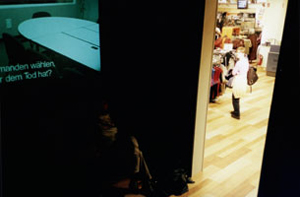 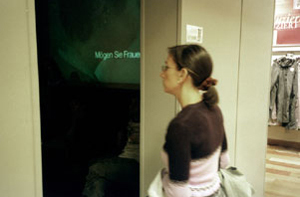 
|













